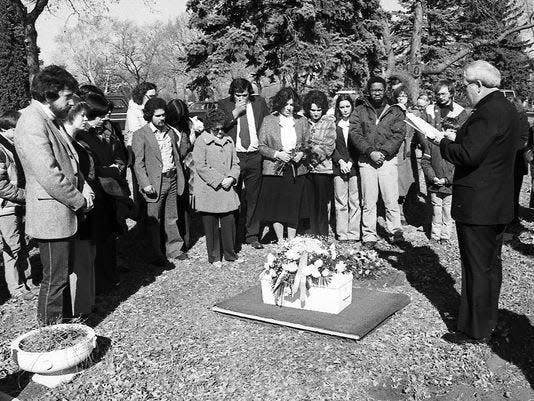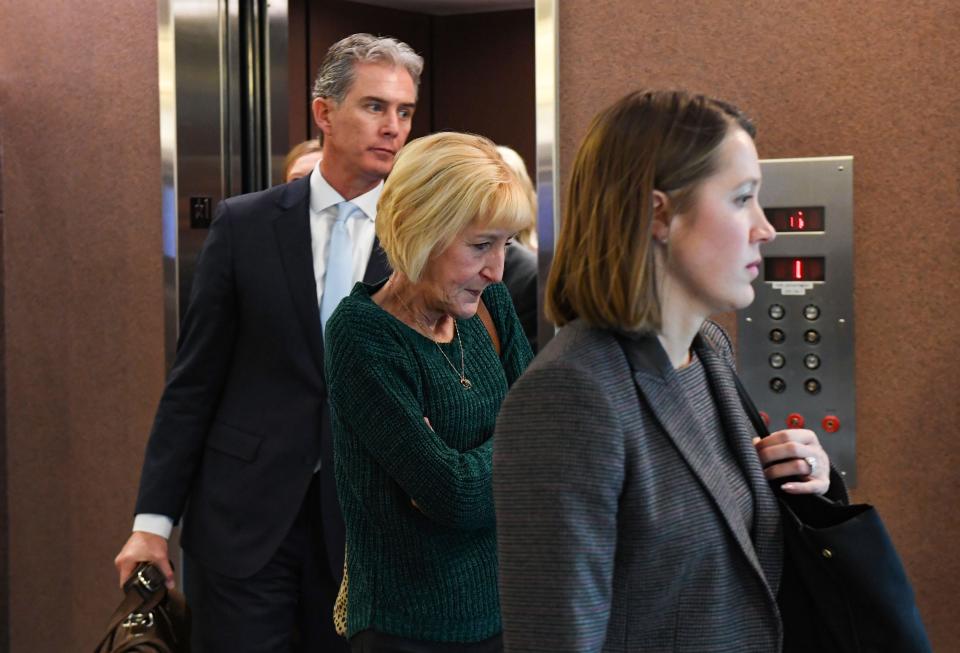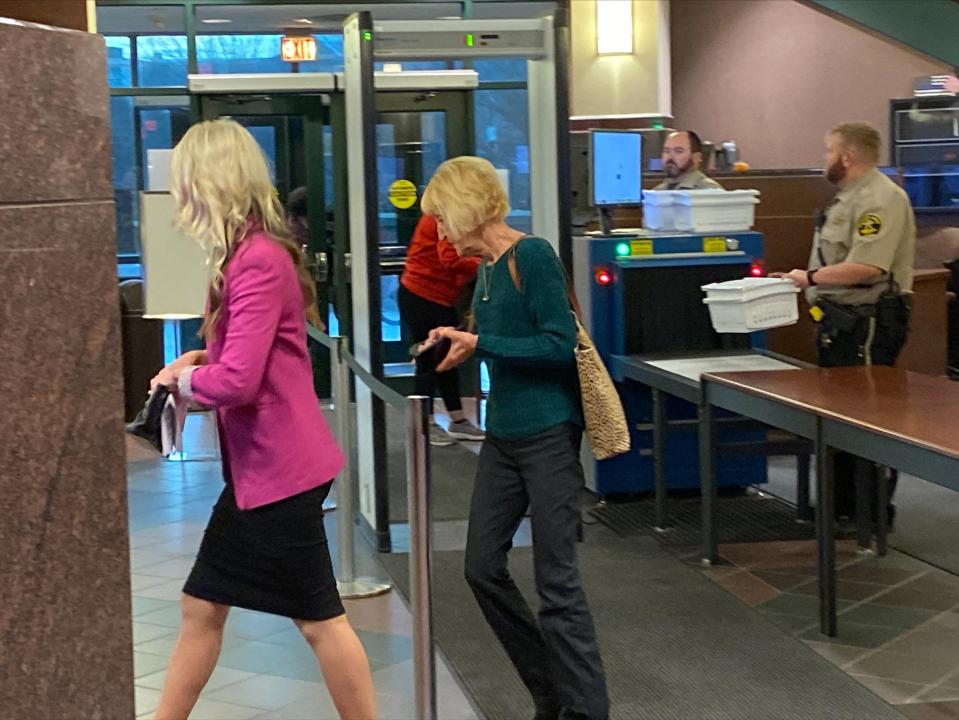Six things we learned during Theresa Bentaas's sentencing in 1981 cold case of Baby Andrew

In the hours-long sentencing hearing for Theresa Bentaas's 1981 case where she was found guilty of the manslaughter of her newborn baby, several new details were released that had not been previously released publicly.
Bentaas was sentenced to 10 years in the women's prison with 9 years suspended and a credit for time served Thursday. Judge Bradley Zell said that she probably won't serve more than 60 days starting in mid-January.
A witness for the defense said Bentaas suffered from "complete pregnancy denial" and she wasn't even aware she was pregnant until the baby was being born. The defense also said that Bentaas never had a name for the child and that when questioned about the death in 2019 referred to him as Baby Andrew, which was the name bestowed upon him by a church that buried him.
More: Baby Andrew was found in a ditch in 1981. Here's what we know about the case after 40 years
1. It's likely Baby Andrew didn't die of exposure
Baby Andrew was found on Feb. 28, 1981 in a ditch with two blankets wrapped around him.
A coroner at the time found the cause of death was likely to be exposure to the cold and blood loss.
During the hearing Thursday, it was revealed the baby had a small portion of air in his lung and air in his stomach.
Bentaas's defense argued that Andrew was born, possibly took one breath and passed away.
Bentaas told a psychologist, who testified as a witness during the hearing, that when Andrew was born he did not look like what a baby should look like. He appeared lifeless and "ghostlike," and was not crying or kicking.
In his sentencing statement, Judge Bradley Zell said there was no evidence that Andrew died due to exposure.
"(Andrew) did not live very long as stated by the medical expert," he said. "We really don't know if the baby born in 1981 would've survived with medical care but we do know it's chance for survival would've greatly increased."
2. "She did not kill her baby. She lost a son"

During the defense's statements, Raleigh Hansman said that the death of Andrew happened to Bentaas and not because of her.
"She did not kill her baby. She lost a son," Hansman said, adding that it was perfectly legal for Bentaas to have a home birth and keep her medical information private.
While Bentaas did enter an Alford plea, it was a compromise, Hansman said, so she could maintain her innocence and have the opportunity to share what happened when she gave birth at 19-years-old.
More: Theresa Bentaas changes plea in 'Baby Andrew' case, found guilty on manslaughter charge
"Make no mistake, my client has never admitted to killing her child because she did not do that," Hansman said.
3. Five years after she gave birth to Andrew, Bentaas gave birth to a baby girl in a very similar fashion
Five years after Baby Andrew was born at home and died, Bentaas became pregnant again. She did not know she was pregnant until later on in the pregnancy and was surprised when the baby came early, according to court proceedings Thursday.
Bentaas again gave birth at home but her stepfather and mother were home and came into her room when they heard what sounded like a baby crying, Zell said. They found Bentaas nursing a swaddled baby and called 911. Both of them were unaware Bentaas was pregnant.

Bentaas and her baby girl were taken to the hospital where Bentaas eventually decided to keep the baby after telling her future husband about the child, Zell said. The couple raised the baby girl and had another child in 1990.
Zell said it's unknown what would've happened if Bentaas's parents hadn't heard the second baby crying
4. Bentaas and her husband have not been able to talk publicly about the case
Theresa's husband, Dirk, is considered a recognized victim under South Dakota law, meaning that he and Theresa have not been able to talk about the case together for the past two and a half years, Hansman revealed during the defense's statements.
More: Mother in 'Baby Andrew' case will be prosecuted under 1981 laws. Here's what that means.
It was determined that Dirk was Baby Andrew's father but he never officially knew about Bentaas's pregnancy even though he suspected it, according to the state prosecution.
In a victim's impact statement submitted to the court, Dirk said that it's been the most isolating experience of his life and Hansman called the experience the biggest elephant in the room.
"Nobody said anything, nobody reached out," Hansman said of Dirk's experience after Theresa was arrested.
Dirk, in his impact statement, recommended the court not impose any time against Bentaas.
5. Bentaas suffered from 'complete pregnancy denial'
During a forensic psychiatric evaluation completed in February 2020, a psychologist diagnosed Bentaas with having experienced complete pregnancy denial when she was 19.
Complete pregnancy denial happens when a pregnant person does not recognize they're pregnant until the moment they give birth, Dr. Cara Angelotta of Northwestern University explained over Zoom to the courtroom. The phenomenon occurs roughly in 1 out of 2,500 pregnancies.
"[It is] three times more likely than giving birth to triplets," Angelotta said.
More: 'I consider him my long lost son:' Man who found Baby Andrew speaks out after arrest
Angelotta said she spent nearly five hours with Bentaas and went through her medical history, the police file as well as completed a full psychiatric evaluation before diagnosing her.
Most people suffering from complete pregnancy denial end up giving birth at home, like Bentaas did both times she was pregnant," Angelotta said. People who experience it say that they didn't know they were pregnant because they didn't have any noticeable weight gain, already had irregular menstrual cycles and misinterpret labor as muscle cramps.
"What she reported to police is a textbook case of complete pregnancy denial," Angelotta said.
6. Bentaas kept the name the church gave the baby

Bentaas accepted the name the church gave the baby, Angelotta said after she was questioned by the prosecution about the baby's name.
"She never named him but accepted the name the church gave him," Angelotta said.
Bentaas referred to the baby as Andrew throughout her psychological evaluation, Angelotta said.
Follow Annie Todd on Twitter @AnnieTodd96. Reach out to her with tips, questions and other community news at atodd@argusleader.com or give her a call at 605-215-3757.
This article originally appeared on Sioux Falls Argus Leader: Baby Andrew cold case: New details emerge Theresa Bentaas's sentencing

